The Mosque of Rustem Pasha an Ottoman mosque located in Hasırcılar Çarşısı the Tahtakale neighborhood, of the Fatih district of Istanbul, Turkey.
Mosque of Rustem Pasha was designed by Ottoman imperial architect Mimar Sinan for Grand Vizier Damat Rustem Pasha (husband of one of the daughters of Suleiman the Magnificent, Princess Mihrimah). Built in 1560 by Sinan for Rüstem Paşa, son-in-law and grand vizier of Süleyman the Magnificent, it is a showpiece of the best Ottoman architecture and tilework, albeit on a small scale. It is thought to have been the prototype for Sinan’s greatest work, the Selimiye in Edirne. At the top of the two sets of entry steps there is a terrace and the mosque’s colonnaded porch. You’ll notice at once the panels of İznik faïence set into the mosque’s facade.
The interior is covered in similarly gorgeous tiles and features a lovely dome, supported by four tiled pillars. The preponderance of tiles was Rüstem Paşa’s way of signalling his wealth and influence İznik tiles being particularly expensive and desirable. It may not have assisted his passage into the higher realm, though, because by all accounts he was a loathsome character. His contemporaries dubbed him Kehle-i-Ikbal (the Louse of Fortune) because he was found to be infected with lice on the eve of his marriage to Mihrimah, Süleyman’s favourite daughter.
He is best remembered for plotting with Roxelana to turn Süleyman against his favourite son, Mustafa. They were successful and Mustafa was strangled in 1553 on his father’s orders. The mosque is easy to miss because it’s not at street level. There’s a set of access stairs on Hasırcılar Caddesi and another on the small street that runs right (north) off Hasırcılar Caddesi to the Golden Horn.
Exterior
The mosque was built on a high terrace over a complex of vaulted shops, whose rents were intended to financially support the mosque complex. Narrow, twisting interior flights of steps in the corners give access to a spacious courtyard. The mosque has a double porch with five domed bays, from which projects a deep and low roof supported by a row of columns
Interior
The Rüstem Pasha Mosque is famous for its large quantities of exquisite Iznik tiles, set in a very wide variety of beautiful floral and geometric designs, which cover not only the façade of the porch but also the mihrab, minbar, walls, columns and on the façade of the porch outside. These tiles exhibit the early use of a tomato-red color that would become characteristic of İznik pottery. Some of the tiles, particularly those in a large panel under the portico to the left main entrance, are decorated with sage green and dark manganese purple that are characteristic of the earlier ‘Damascus ware’ coloring scheme. No other mosque in Istanbul makes such a lavish use of these tiles.
The plan of the building is basically that of an octagon inscribed in a rectangle. The main dome rests on four semi-domes; not on the axes but in the diagonals of the building. The arches of the dome spring from four octagonal pillar two on the north, two on the south and from piers projecting from the east and west walls. To the north and south are galleries supported by pillars and by small marble columns between them.
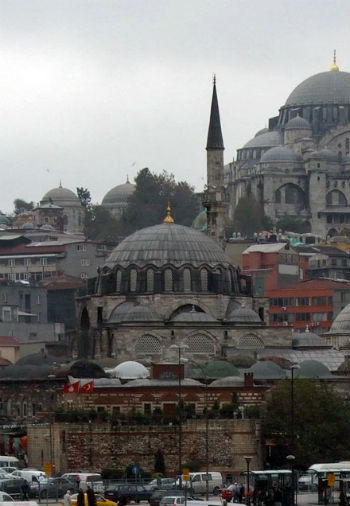
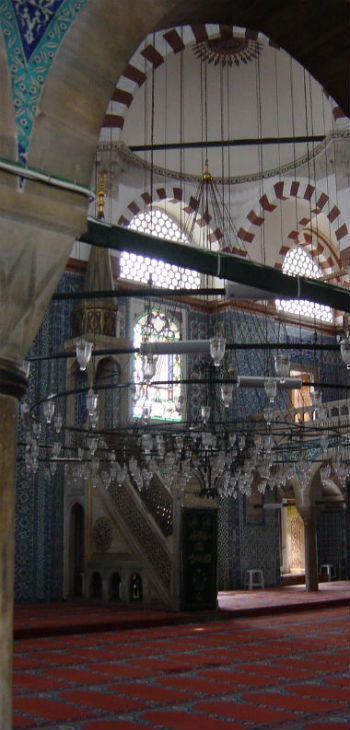
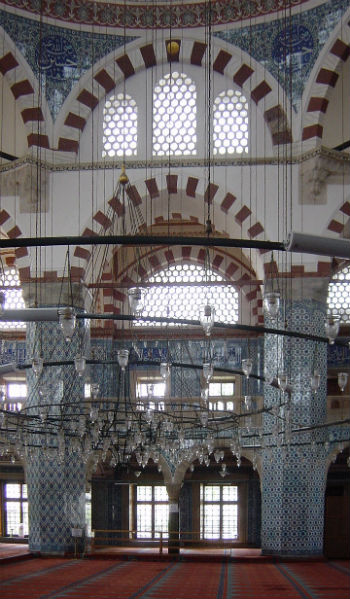
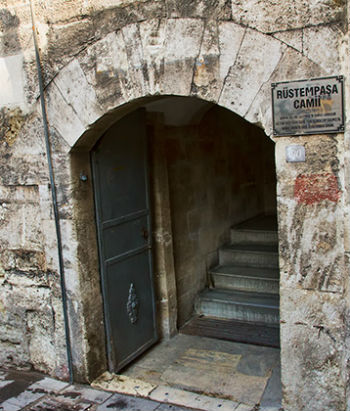
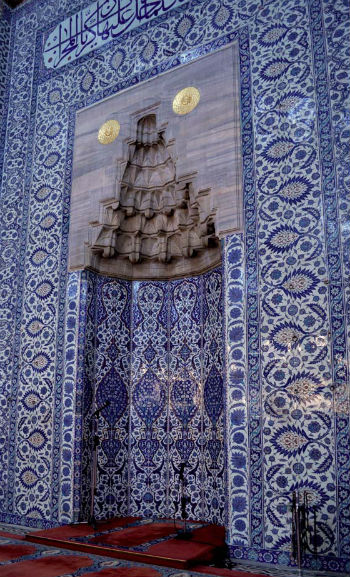


Interesting setting, above the fray. Smaller and thus more intimate than the giant mosques, this was an island of peace in an otherwise crazy area (I was suffering Spice Market burnout at the time). If you are in love with the tile work of Istanbul, this place should not be missed. Central location.
Rustem Pasha Mosque was commissioned by Suleyman’s son in law and built by Sinan. It was completed in 1561 It is located in an old and busy market area. The mosque is known for its beautiful Iznik tiles from the sixteenth century covering entire walls. It is a very special mosque and really lovely inside.
We walked here from the Great Mosque on a Saturday – didn't see the warnings until later. It was great fun but if you are claustrophobic, try to see this Mosque on another day! It has a different layout to others and is much quieter and peaceful. The tiles are beautiful.
When you fint this mosque it is fantastic: The whole mosque is decorated with blue Iznik tiles. This mosque is really blue!
It was quiet and deserted when I visited, as compared to the other mosques. It is very close to Yeni Mosque so worth the trip if you are nearby. The mosque is smaller and covered in blue tiles.
Hard to find, but very nice tiles inside. Go up the small stairs to get to the mosque entrance.
This small mosque was, for me, the most beautiful I've seen, but then I might be slightly prejudiced because blue is my favourite colour! The tiles here are just mind boggling!
Rustem Pasha Mosque always enchants me with its most beautiful tiles and carved woodwork (doors). Don't miss this mosque, you don't need to see all the big ones – but this one, really I mean it, go there for a quiet, beautiful, enriching visit.
To get there: take the right turn inside spice bazaar and just follow the narrow street…
A very old Mosque close to the Spice Bazaar. Famous for it's colourful tiles that are set in floral design.
This small mosque is just west of the Spice Bazaar and should not be missed…even after seeing the tile museum in Konya. The tile work is incredible!